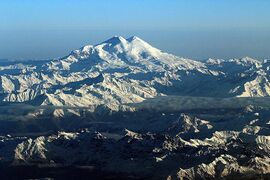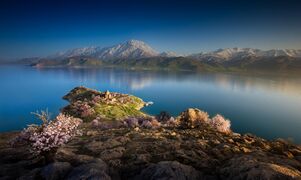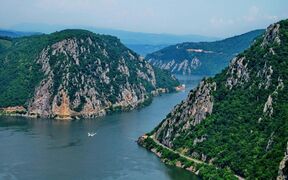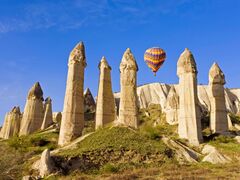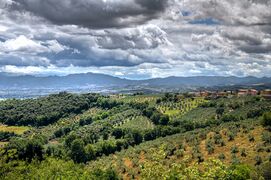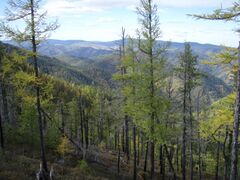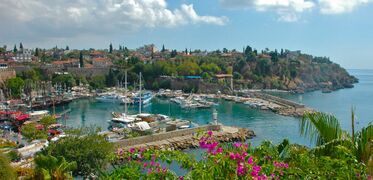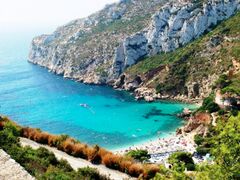Mesogeia: Difference between revisions
(Created page with "{{Infobox country |native_name = ''Βασιλεία Μεσογεια'' |conventional_long_name = Empire of Mesogeia |common_name = Mesogei...") |
|||
| Line 450: | Line 450: | ||
[category:Mesogeia]][[category:Countries]][[category:monarchies]][[Category:Constitutional monarchies]] | [[category:Mesogeia]][[category:Countries]][[category:monarchies]][[Category:Constitutional monarchies]] | ||
[[Category:Parliamentary democracies]][[Category:Unitary states]] | [[Category:Parliamentary democracies]][[Category:Unitary states]] | ||
Revision as of 20:34, 30 March 2019
Empire of Mesogeia Βασιλεία Μεσογεια | |
|---|---|
Coat of arms
| |
| Motto: "Dei Gratia imperator boleti proceritas" (Mesogeian) "God's Grace Aids the Emperor!" | |
| Anthem: TBD Royal anthem: TBD | |
| Capital | Alexandropolis |
| Official languages | Mesogeian |
| Demonym(s) | Mesogeian |
| Government | de jure Absolute monarchy, de-facto Unitary parliamentary constitutional monarchy |
• Empress | Elena II |
| TBD | |
| Legislature | Parliament |
| Senate Curiate Assembly | |
| Chamber of Plebeians Centuriate Assembly | |
| Population | |
• 2018 estimate | 154,326,000 |
• 2010 census | 150,205,000 |
| GDP (nominal) | 2018 estimate |
• Total | 3.7 trillion |
• Per capita | 24,430 |
| Gini (2018) | medium |
| HDI (2018) | very high |
| Currency | Mesogeian drachma (₯) |
| Date format | dd.mm.yyyy |
| Driving side | right |
| Calling code | 31 |
| ISO 3166 code | MESO |
| Internet TLD | .MES |
Mesogeia, officially known as the Empire of Mesogeia is a sovereign nation. Mesogeia name means the "middle land", and it is often known as "The Middle Kingdom". Mesogeia has an estimated population of 150 million people.
The Empire of Mesogeia is considered to be an absolute monarchy by tradition, while in practice it is unitary parliamentary democracy presided over by a nominally constitutional monarch. The current monarch is Empress Elena II, who as reigned since 1970, making her one of the longest reigning monarchs in Mesogeian history.
Mesogeia's capital and largest city is Alexandropolis; which is also a major political, cultural, and economic centre. Other major urban centers include Pharopoli, Troiana, Memphis, Chrysopolis, Aithias, and Farsargadae. The official language is Morean Greek, while various other languages are spoken regionally including Farsi, Aratianan, Anatolian, and Aramaian in the central regions; with Alban and Lazic family languages in the north; and Pharosian, and Saramatian in the south. In addition to this French, English, Italian, and other western languages are spoken at the Imperial court and in the major urban centers.
Mesogeia is a developed country with a large and diversified economy. The Empire of Mesogeia has a high quality of life, and a very high standard of living. Mesogeia is a major player in the world stage being both a regional and great power with notable cultural, diplomatic, economic, military, political, and scientific, influence. Mesogeia is home to one of the oldest civilizations in the world. As a result of its rich cultural history, Mesogeia is the site of close to 50 world heritage sites.
Etymology
The origins of the name of Mesogeia are several centuries older then the country itself. The exact origin of the term Mesogeia is shrouded in mystery dating back at least six thousand years. Legends state that the original inhabitants believed Mesogeia to be the centre of the world proclaiming it to be the middle land or Meso gei, as it became known. Eventually the area settled by the ancestors of the modern Mesogeians became known as Mesogeia.
History
Prehistory
The earliest archeological evidence in the territory that is modern Mesogeia is dated to about 2.1 million years ago. In the early twentieth century archeologists discovered the remains of the oldest recorded hominid to reside in what is now Mesogeia, in a cave in the modern province of Pharosia.
The hominid fossils of a Homo Erectus were discovered in the central province of Mesaia, archeologists have even dated between 710,000 and 830,000 years ago. Meanwhile in the region of what constitutes the modern province of Morea the remains of Homo sapiens were unearthed (dated to 250,000 and 125,000 years ago). Several hunter gather societies are attested between the 14th and 9th millennia BC living around the major waterways of the region. The earliest established settlements in Mesogeia are dated to this period.
Between the 9th and 4th millennia BC, a wide range of changes occurred in which the largely hunter-gather societies of Mesogeia transitioned into agricultural society residing in settled towns and later cities. In the 9th millennia BC, the domestication of dogs, pigs, goats, and sheep occurred. In the succeeding millennia in Mesogeia archeological evidence suggests that agricultural produce such as wheat and barley. In the 7th millennia BC, cats were domesticated,. By the 6th millennia BC, cattle were domesticated, wine and cheese were first produced in the state. By the 5th millennia BC, agriculture was firmly established in central Mesogeia and was expanding; by the end of the millennia, beer and the wheel had been developed. By the 4th century BC an agricultural civilization was firmly established in what is known southern and central Mesogeia. Mesogeian writing system originated in this period, as did several ancient Mesogeian states.
Ancient Mesogeia
For centuries the legends and history of Mesogeia have often been tied closely together. A unified state was established sometime around 3,100 BC, in PLACENAME (one of the oldest continuously inhabited cities in Mesgoeia). Mesogeia's first dynasty was called the Mesogeian dynasty after the semi-mythical founder Mesogeius. The first reported King of Mesogeia, was a man who is said to have been descended from the gods. Legends related in the Mesogeian holy book, the Avesta claim that Mesogeius and his twelve sons Troianus, Anatolius, Farsius, Aratius, Isauris, Farasus, Nomadias, Saramatius, Paralios, Lazicus, Magus, and Albus arrived in what is modern Mesogeia. Texts in the Avesta claim that the Mesogeians subjugated the inhabitants and declared overlordship over them. Modern historians have concluded that all modern ethnically Mesogeian peoples are descended from one of the twelve sons of Mesogeius. The Avesta asserts that Mesogeius and his sons enslaved the previous inhabitants of the area, eventually eliminating them as an independent race.
Following the death of Mesogeius in 3075 BC, his line would rule central and southern Mesogeia for well over a thousand years, ruling longer then any other dynasty in the history of the Mesogeian monarchs. Like Mesogeius himself many of the early kings of the Mesogeian dynasty are considered to be legendary or at least semi-mythical with many legends and myths attributed to them. Several kingdoms existed besides the kingdom based in PLACENAME, but this kingdom known to modern historians as the Middle Kingdom was arguably the strongest and most powerful..
Sometime around 1644 BC the ancient state based at PLACENAME collapsed and the region was plunged into a time of disunity known as the age of the warring states. This period lasted for approximately four centuries, only ending in 1176 when the Alcaeid dynasty was established at Chrysopolis. The Alcaeid dynasty was the first dynasty to take the title of Emperor; and it is from this period that the emperors of Mesogeia are generally dated. The Alcaeid empire expanded over the next several centuries to the point that by the late eighth century BC, the Mesogeian peoples, together with the "pre-unified Mesogeian" kingdoms, were all under the dominion of the Alcaeid Empire.
The great king Artaxsaca VII (known under the reign name of Alcaeus XXIX) reigning in the late eight century BC, had a profound impact on the history of Mesogeia. His policy of religious tolerance, his advocacy for basic humane principals shaped the empire for the next several centuries. The Alcaeid empire is notable for its use of an official language, national coinage, and a network of royal roads and postal system. The empire of the Alcaieds was unique in the fact that it was governed from four capital cities, Chrysopolis, Farsargadae, Sousa, and Ecbatana. The sixth century BC saw the Alcaeid empire's conquest of the Morean states. The assimilation of the Greek speaking Morean city-states in the north led to the eventual hellenization of the Alcaied state as a whole; this is evidenced in the hellenized Alexander IX who reigned in the 4th century BC. The centuries between the conquest of the north by Shapur I in the sixth century BC and the accession of Alexander IX in the 4th century BC on the celestial throne are cited as the first golden age of Mesogeian culture. Five of the seven great schools of though developed between the 6th and 3rd centuries. Only PLACEHOLDER is older, dating to the 15th century BC.
By the 4th century the Alcaeid empire was not the only power in what is modern Mesogeia. The Republic of Troiana having expanded across the region of Romaica and northern Mesogeia over the last two centuries eventually established itself as the most powerful state in the north. The first contacts between the Alcaeid Empire and its northern neighbor were peaceful, but ultimately relations soured and the two powers fought successive wars over the next several centuries.
The Alcaeids would rule southern and central Mesogeia for several more centuries until the last ruler, Roxana XII died in 27 BC. Roxana is noted for her union with PLACEHOLDER, the Consul of Troiana. Contemporaries at the time in Troiana described the union as the triumph of the north over the south, or the republic over monarchy; while contemporaries residiing in Roxana's realm described the union as a triumph over the north describing how PLACEHOLDER was defeated by the charms of a woman. Whatever the case, a large portion of what is now modern Mesogeia was firmly united upon that union.
Despite birthing several children by her union to PLACEHOLDER, the death of Roxana in 27 BC was followed by a civil war that nearly destroyed everything the Alcaeids had spent centuries building. Eventually in 21 BC, following several years of war Heraclius (a reported grandson of Roxana), a Romaican defeated PLACEHOLDER and declared himself Emperor of Mesogeia. Instead of ruling from his grandmother's capital, Heraclius the great established the city of Troiana as his capital; the Troianians and Romaican Republic having by then established itself as the most formidable successor states of the ancient Alcaeid empire.
The empire established by Heraclius and his successors was a massive state stretching from Romaica in the north to Pharosia in south. The Troianian (or Romaican empire as it was sometimes known) as the progenitor of modern Mesogeia left a lasting legacy on its government, military, culture, religion, laws, architecture, literature, and languages. During the 1st and 2nd centuries, the Empire of the Toianians was powerful cultural, political, economical and military power. The empire ruled by the Heraclians experienced two-hundred years of peace and prosperity.
By 3rd century however the military power of Troiana had declined so much that the empire was on the verge of collapse, with shrinking borders in the north and the south. Northern neighbors and western foes such as Scythia had once more become a thorn in the side of the Middle Kingdom.
The decline of the Empire of the Romaicans was halted in the 4th century by the successful reign of Michael the Great who secured the empire's borders and established christianity as the state religion of the largely pagan empire. The Troianian Empire managed to survive until it was split into two halves in 547 AD following the death of Constantine I (later known as the Great), the last formidable Emperor capable of holding the vast empire together.
Medieval Mesogeia
Early Modern Age
Modern Age
Geography and climate
Geography
The Empire of Mesogeia covers a total area of 11,111,178 square kilometres (4,290,050 sq mi) of which 5.4% is water. The land of Mesogeia consists of a mainland and a few outlying islands near the coast. The highest point in Mesogeia is Mount Dios at 5,205m (17,076 feet). The geography of Mesogeia is characterized by mountain ranges along the coast and around the interior forming the Mesogeian highlands; with fertile valleys, and plains lying between them
Climate
The climate of Mesogeia is incredibly diverse and complex, having 11 distinct climate zones, ranging from temperate, mediterranean, arid and semi-arid, to subtropical. Winters can vary across the country, but they are generally mild to cold and wet, with snowfall in the north and along the highest mountain ranges and plateaus. Summers can be hot and dry with frequent thunderstorms throughout the country. The highlands are generally cooler in the summer as a result of their high elevation. May is generally the wettest month of the year while July and August are the driest on average. The spring and Autumn months are more mild
The coastal regions of Mesogeia and the outlying islands are characterized by a typically mediterranean climate. Some mountainous areas feature alpine climate types contrasting the typical mediterranean climate of the country. The interior's climate varies from region to region, they are generally temperate A continental climate distinct from the mediterranean climate of the coast prevails in the country's interior, particularly around the Anatolian Highlands and Farsian Highlands, and Aratian Highlands, as a result of mountain formations around the coast. The southernmost potions of the empire are unusually hot and dry, described as arid and featuring deserts.
- Landscapes of Mesogeia
- Anatolian highlands in Aratiana.jpg
The Anatolian Highlands are the site of some of the best farmland in the Empire
Politics
The Empire of Mesogeia is a unitary parliamentary state, ruled by an hereditary monarch, but the country possess strong democratic traditions and principals. Whereas the Emperor (or Empress in the case of the current monarch) of Mesogeia is considered to be an absolute monarch with ultimate powers by tradition, she is however a constitutional monarch by law as a result of an un-codified constitution
Being a unitary state the central government based in the capital city Alexandropolis holds supreme power in the land. Elena II is the reigning Empress and head of state, while (insert politician name) is the head of government as Prime Minister.
Government
The government of Mesogeia is divided into three branches, the legislature, executive and judicial branches. The Mesogeian legislature is unique for being composed of four houses. The legislative power is vested in the tetracameral Parliament of Mesogeia. The parliament consisting of four houses; a Senate of appointed and hereditary nobles, the Curiate Assembly consisting of appointed members of the clergy, the Chamber of Plebeians composed of commoners residing in the urban areas, and the Centuriate Assembly composed of people in generally rural areas
The Mesogeian parliament meets in the Palace of Magnaula, one of the oldest imperial palaces in the country. The Prime Minister of Mesogeia is the head of government, while the monarch is head of state. The position of Prime Minister generally goes to the leader of the party or coalition commanding a majority (this is however not always the case) of the seats in the two lower houses, the Centuriate Assembly and Chamber of Plebeians. The Emperor ceremonially invites the leader of the majority to form a government.
The country two major political parties are the Conservative party, and the Liberal Party, both parties having their origins in the empire's ancient chariot racing teams, the blue (Galanoi) faction and the green (Prasinoi) faction respectively.
Military
The Mesogeian armed forces numbers some 750,000 active personnel along with 350,000 in the reserve forces. The armed forces of Mesogeia consists of three branches: the Imperial Army, Imperial Navy, Imperial Air Force
Administrative divisions
The Empire of Mesogeia is divided into thirty-four provinces, which are traditionally called Satrapies. The thirty-four satrapies from north to south are Voreia, Taurica, Romaika, Macedon, Asturia, Saramatia, Frankonia, Alania, Pristina, Cantabria, Epirus, Mikrosa, Dacia, Vlachia, Morea, Thrace, Dardanellia, Anatolia, Aratiana, Colchis, Farsia, Mesaia, Aramaia Isauris, Paralia, Phocaea, Pharosia, Kyrinaike, Carchidona, Nabataia, Leptania, Nomadias, Marmarica, Scythia, and Notia. The provinces are further divided into over 300 themata, which are further subdivided into 3,500 prefectures known as nomes or eparchia in some parts. The nomes are subdivided into over 10,000 municipalities, villages and communities known collectively as demos or pagus.
Economy
Mesogeia has a mixed economy. In the modern age it is a highly developed country with a high standard of living. The Mesogeian economy comprises the service sector (63%), industrial sector (28.1%), and the agricultural sector, accounting for only 8.9%.
Mesogeia is well known for its shipping, food, design, fashion, and agricultural industries. The shipping industry is a major player in the country's economy, accounting for a substantial percentage of the country's GDP. The agricultural sector of the country is surprisingly large for a developed country. Tourism also plays an important role in the country's economy with around 50 million annual tourists each year.
Agriculture
The agricultural sector accounts for just 8.9% of the Mesogeian economy; it is however a powerhouse nevertheless with the country being a major producer of several agricultural products including wine, olive oil, olives, cherries, tobacco, tea, tomatoes, lemons, pears, apricots, wheat, legumes, honey, strawberries, onions, figs, dates, grapes, dairy products, poultry, and beef. Mesogeia produces a substantial amount of meat and dairy products to be a major exporter on the world stage.
A traditional sea-power, Mesogeia has a large fishing industry, and the nation is known for being one of the highest consumers of fish products in the world. Mesogeia has one of the world's largest fishing fleets, and the fish caught by Mesogeian fisherman accounts for a substantial portion of the world's fish.
Energy
Mesogeia has a substantial amount of natural gas and oil reserves, but the country does not produce enough to be self sufficient. As a result Mesogeia imports oil and gas from foreign countries due to being unable to access the untapped natural gas reserves.
Since at least the mid 1980s, the Mesogeian government has looked for alternative energies to natural gas; as a result the country has invested heavily in nuclear power as well as renewable energies such as solar power, wind power, and hydroelectric power. Despite this the country is still reliant on non-renewable energy (accounting for 77%), with only a small portion of the country's energy consumption comes from renewable energy (around 16.4%)
Shipping industry
Mesogeia has a large and competitive shipping industry that plays major role in the country's economy. The ancient Mesogeians were a seafaring people and the empire of Mesogeia is considered to be a maritime power; it should be noted that for centuries shipping has played an important role in the empire's economy. In the present age shipping remains an important part of the nation's economy, accounting for around 5% of the nation's GDP.
Over the course of the eighteenth and nineteenth centuries several businessmen have amassed fortunes in the shipping and shipbuilding industries
Tourism
Tourism is an important sector in Mesogeia's economy. Mesogeia is one of the most visited countries in the world, with 50 million annual tourists as of 2018. Mesogeia is home to fifty plus world heritage sites, and has several notable cities of cultural interest, including Alexandropolis, Troaiana, Crysopolis, Pharopoli, and Farsargadae.
The country's many beaches, seaside resorts, and rural picturesque villages are popular tourists destinations known for their tranquility and natural beauty.
Mesogeia's most visited landmarks include, in no particular order: Galata Tower, Magnaula Palace, Imperial Hippodrome, Imperial Palace of Alexandropolis, National Museum of Mesogeia, Hagia Triada Basilica, Anemas Prison, Baths of Alcides, Bosphoros Palace, Cathedral of Hagia Aima, Imperial Necropolis at Sousa, Acropolis of Troiana, Necropolis of Amaseia, Basilica of Saint Marios, Blachernai Castle, Palace of Memphis, Hiereia Palace, Our Lady of Alexandropolis, ruins of Aegai, and so on.
Infrastructure
Demographics
Languages
Religion
There are several distinct religions in the Mesogeian Empire including Christianity, Islam, Judaism, Mesogeian Polytheism. The largest religious denomination in Mesogeia is Christianity with the Mesogeian Orthodox Church forming the vast majority of Christians in the country. The Mesogeian Orthodox Church functions as the state church of the empire, having several privileges not afforded to other religions.
Ethnic groups
WIP
Major cities
Largest cities or towns in Mesogeia
Imperial Ministry of the Interior | |||||||||
|---|---|---|---|---|---|---|---|---|---|
| Rank | Province | Pop. | Rank | Province | Pop. | ||||
| Alexandroplis Alexandroplis Pharopoli Pharopoli |
1 | Alexandroplis | Anatolia, Mesogeia | 8,643,202 | 11 | Carthagena | Carthagena | 786,424 | Troiana Troiana Memphis, Mesogeia Memphis, Mesogeia |
| 2 | Pharopoli | Pharosia | 4,170,044 | 12 | Thessalonica | Morea | 768,196 | ||
| 3 | Troiana | Romaika | 3,862,331 | 13 | Tigranocerta | Aratiana | 730,266 | ||
| 4 | Memphis, Mesogeia | Pharosia | 2,514,195 | 14 | Dorylaion | Anatolia, Mesogeia | 717,135 | ||
| 5 | Chrysopolis | Mesaia | 2,032,665 | 15 | Latinopoli | Romaika | 701,403 | ||
| 6 | Aithias | Morea | 1,708,646 | 16 | Thebais | Pharosia | 687,588 | ||
| 7 | Fasargadae | Farsia | 1,283,154 | 17 | Naukratis | Pharosia | 670,494 | ||
| 8 | Serdica | Thrace, Mesogeia | 1,136,035 | 18 | Valentina | Phocaea | 639,034 | ||
| 9 | Frangopolis | Frankonia | 855,393 | 19 | Berenice | Marmarica | 631,155 | ||
| 10 | Caesarea Mazaca | Anatolia, Mesogeia | 832,214 | 20 | Clysma | Notia | 565,716 | ||
Eductation
Education is compulsory from ages six to sixteen. Education in Mesogeia is overseen by the Imperial Ministry of Education, and it is divided into four stages: Nursery School (ages 4-6), primary school (ages 6-13), Gymnasio (ages 13-15), Lyceum (15-18), and University. Mesogeia has a long history of education and it should be noted that the education of the nation's youth is valued highly in Mesogeian society.
Tertiary education in Mesogeia is divided between public universities, private universities and prestigious and very exclusive graduate schools. There a number of centers of higher learning in the country, including Moueseion University (which is the oldest having origins in antiquity), Alexandropolis University (5th century AD), Gondishapur University (6th century), Ctesiphon University (8th century), Memphis University (10th century), University of Troiana (1130), Durres University (1436).
Mesogeia has a number of boarding schools, the most prestigious of which are Magnaura College, Mieza College, Derkos College, and Edessa College.
Culture
The culture of Mesogeia 5,000 years of history. Mesogeia has developed a uniquely diverse culture, shaped by the cultures, customs, and traditions of various regional kingdoms and states that flourished in the area known as Mesogeia for centuries. The foundations for Mesogeian theology, mythology, philosophy, and literature all originated in the Avestic Period (c. 3100-800 BC) and the later Classical Period (c. 800 BC-547 AD). Mesogeia is notable for its cultural, religious, and ethnic diversity.
Art
Mesogeia has a rich artistic history, comprising many elements, including architecture, calligraphy ceramic art, icon painting, metalworking, mosaic art, painting, pottery, sculpture, stonemasonry, textile art, and weaving.
Architecture
Mesogeian architecture is the combined elements and characteristics of various cultures, states, and peoples preceding the modern Mesogeian Empire. Modern architecture of Mesogeia combines Farsian, Saracen, Aratianian, and Romaican influences to create an architectural style that is unique to Mesogeia. The history of architecture in Mesogeia goes back several millennia; and over the course of several centuries Mesogeian architecture has developed unique architectural designs that are both structurally and aesthetically pleasing.
Because Mesogeia is such a diverse country architectural styles vary from region to region in the empire, it should be known that the architectural styles predominate in northern Mesogeia can not be applied to southern Mesogeia.
Literature
Mesogeian literature has its origins in ancient Mesogeian states such as Pharosia and ancient Morea. With a history spanning several centuries, Mesogeian literature has given the world numerous writers, poets, philosophers, and historians, such as (PLACEHOLDER), (PLACEHOLDER), (PLACEHOLDER). The ancient Morean-Romaicans were also well known for their oral traditions, dramatic presentations of comedy and tragedy, pastorals, poetry, drama, epigrams, historiography, and philosophical treatises.
The Morean and Pharosian ancient kingdoms provided some of the earliest known literary works in the world. Historically Mesogeian literature can be divided into three main categories: Ancient literature, Medieval literature, and Modern Mesogeian literature.
Theatre
Mesogeian theatre is a synthesis of the ancient civilizations of Mesogeia. The modern Mesogeian theatre has its roots in the Morean-Romaican cultures of antiquity. The Mesogeian theatrical tradition were influenced by the ancient Greeks. The Imperial Opera House in Alexandropolis is one of the oldest venues for theatrical performances having opened in 1735.
Philosophy
Mesogeian philosophy has its origins in antiquity dating back to 1500 BC. Mesogeian philosophy can be divided into three categories defined historically as Ancient Philosophy, Medeieval Philosophy, and Modern Philosophy. As a result of unprecedented political and social changes, there exists in Mesogeia a wide range of Philosophical schools of thought, which uphold a variety of ideals rooted in both Christian, Muslim and Pagan traditions.
Ancient philosophy refers to the philosophical traditions that emerged from the 15th century BC to the fall of Troiana and the final division of the Troianian Empire in the 5th century AD. There were several formidable Morean-Romaican philosophers including (PLACEHOLDER), (PLACEHOLDER), (PLACEHOLDER).
Medieval philosophy refers to the philosophical traditions that emerged from the 5th century AD to the reunification of the Troianian Empire in the late 14th and early 15th centuries. Philosophy during the medieval period can be further categorized between the two leading faiths at the time Christianity and Islam; both of which influenced the others.
Philosophy after the 14th century refers to the modern age of Mesogeia. When the Northern and Southern Troianian kingdoms, known respectively as Romaica and Anatolia, united into one state in the 14th century the philosophy that followed took a modernist approach. Philosophers of the day believed that it was the destiny of Romaica to rule all of Mesogeia. This ideal was opposed by the independent states that had existed alongside Romaika for centuries. One by one they all fell until Mesogeia was united under one Emperor.
Philosophy in Mesogeia experienced a rebirth at the end of the Middle Ages as a result of two conflicting forces, those that supported the westernization of Mesogeia and those that opposed it claiming that the empire's destiny was in the east and that it was unique civilization straddling both east and west.
Mythology
Mesogeian mythology corresponds to ancient Mesogeian folklore and the stories of mythical persons, creatures, and places. The ancient Mesogeians had a pantheon that included countless gods and goddesses, including: Ombrius, Anthea, Pelagaios, Chrysea, Phoebus, Elaphiaia, Aithyia, Salphinx, Aisais, Aetius, Marius, Melaina, Lenaius, Serapis, Polymetis, Epimelius, Selene, Oikia, Skouros, Alcides, Aegocerus, Priapus, and so on.
The myths of ancient Mesogeia played an important role in the shaping of Mesogeian culture. Mesogeian mythology features gods, extraordinary beings, , battles between good and evil, the exploits of heroic heroes and heroines, as well as fantastical creatures.
Music and dance
Mesogeia has a long and varied musical history. Mesogeian music encompasses a wide variety of genres, including folk, classical, and pop music. The origins of traditional music in Mesogeia spans thousands of years, having origins in the 31st century BC.
In the 17th century during the reign of (INSERT EMPEROR NAME) the music of Mesogeia experianced a kind of golden age.
Cinema
Cinema in Mesogeia originated in 1894 with foundation of (INSERT COMPANY NAME) in Pharopoli; the very first film producing company in the country. From the early 20th century the Mesogeian film industry has largely been based in the city of Pharopoli, known for its warm climate.
The nation hosts the Pharaopoli Film Festival, the most important film festival in the Empire of Mesogeia. Noted Mesogeian film actors include: (INSERT NAME), (INSERT NAME), and (INSERT NAME).
Media
Mesogeian television id dominated by four major broadcasters, these are Mesogeian Broadcasting Coperation (MPE), Anatolic Broadcasting System (ASE), Romaika Broadcasting Company (PPE), and Pheonix Broadcasting Company.
Well-known newspapers and magazines, include Alexandropolis Times, Mesogeia Gazette, Mesogeia Today, Pharopoli Times, Troiana Post, Memphis Tribune, Tripolis Times, Thessalonica Inquirer, Farsian Journal, Thebais Register, and Athlitikós.
There are also a number of tabloids of note, including the Helios Herald, The Daily Chronicle, and The Intruder.
Fashion and design
Mesogeian fashion has a long history, that was heavily influenced by the Imperial court of the Mesogeian Emperors. Since the 17th century fashion has been a leading industry in the empire. The city of Alexandropolis is considered to be the fashion capital of Mesogeia.
Major Mesogeian fashion labels, such as (INSERT COMPANY NAME), (INSERT COMPANY NAME), (INSERT COMPANY NAME), to name a few of many are regarded by the fashion world to be among the top fashion house in the world. Renowned fashion designers from Mesogeia include (INSERT NAMES).
Sports
Popular spectator sports in Mesogeia include football, horse (with or without chariots) racing, tennis, rugby, basketball, boxing, wrestling, volleyball, and so on. The most popular sport is of course football (or soccer), which is followed by millions across the empire. The second most popular sport is rugby which rivals Football in its popularity. Basketball is growing in popularity and is popular among the nation's youth and urban areas, while wrestling is popular in the rural areas. Horse/chariot racing is one of the oldest sports still played in Mesogeia; once it was the most popular sport of the empire, it has lost some of its popularity. It maintains a national following today
While Football, rugby, and horse/chariot racing are popular throughout the empire and enjoyed my the massses there are a certain sports that are popular mostly amongst the nobility, this includes jousting, polo (known as Chovgan or Tzykanion), hunting, tennis, and golf. Hunting is practiced mainly by the nobility as a result of several restrictions being placed on the common people; most notably their prohibition from owning firearms without special permits.
A significant portion of the Mesogeian landscape is mountainous, making the country an excellent venue for skiing, snowboarding, hiking, rock climbing and mountain climbing. Water sports such as sailing, rowing, and swimming are popular in Mesogeia as well.
Cuisine
Mesogeian cuisine has developed over several centuries with roots going as far back as the 5th century BC. Modern Mesogeian cuisine, renowned throughout the world has been influenced by the cuisines of ancient civilizations such as Morea, Romaika, Farsia and Pharosia. A Mediterranean diet forms of the basis of Mesogeian cuisine; a diet that consists of a high consumption of olive oil, legumes, cereals such as pasta, fruits, and vegetables, a moderate consumption of dairy and fish products, and a low consumption of non-fish meat products
Cuisine in Mesogeia is noted for its regional diversity and can be categorized into three groups, southern, central, and northern; with varying differences. For instance butter is used for cooking in the north while olive oil being used in the south and central regions. In addition certain regions and provinces are known for traditional specialities.

